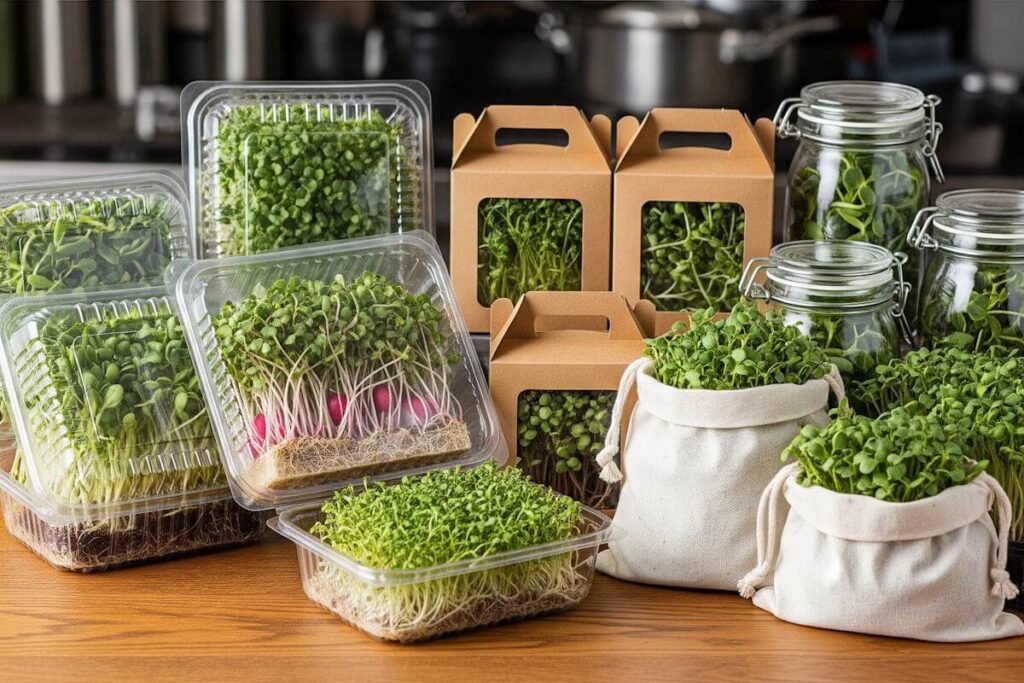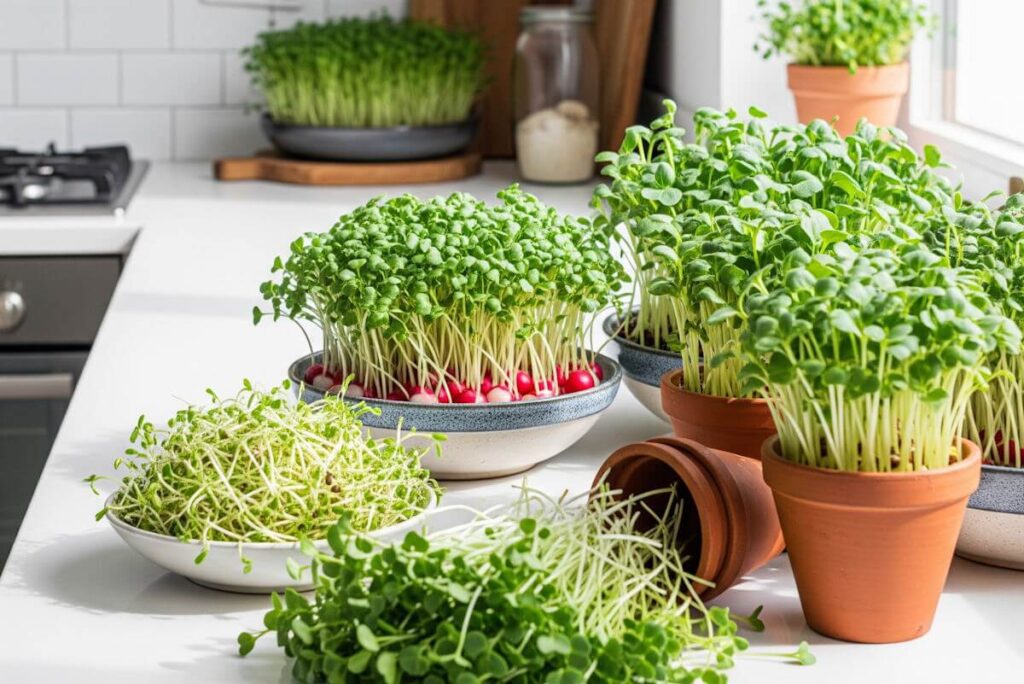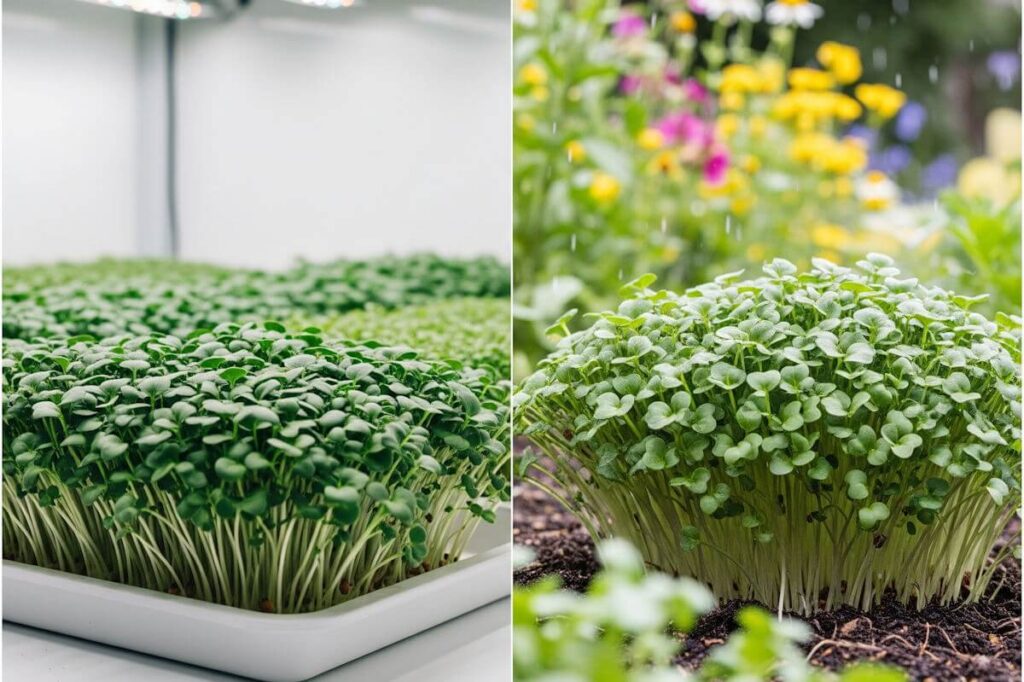Introduction to Microgreens Packaging
Microgreens, the young edible greens harvested just after the first true leaves have developed, have gained significant popularity in recent years due to their intense flavors and high nutritional value. As a burgeoning agricultural product, proper packaging plays a vital role in maintaining their freshness, extending their shelf life, and enhancing their visual appeal to consumers. Selecting the right packaging solution is critical for anyone involved in selling microgreens locally, as it directly affects the quality of the product delivered to the market.
The delicate nature of microgreens necessitates specialized packaging that can adequately support their unique characteristics. These tender greens are highly perishable, and their shelf life can be significantly impacted by exposure to light, moisture, and temperature fluctuations. Therefore, packaging solutions must not only preserve the greens but also protect them from physical damage during transport and storage. Furthermore, presentation is key in attracting potential customers, and appealing packaging can set one vendor apart from another in a competitive market.
Different types of packaging are available for microgreens, including clamshell containers, biodegradable pouches, and even reusable options. Each type offers distinct advantages, such as breathability, moisture control, and ease of use. The choice of packaging material can also convey an environmental message, aligning branding efforts with sustainability trends that many consumers prioritize. In conclusion, understanding the importance of proper packaging is essential in the cultivation and sale of microgreens, as it provides not only a functional purpose but also enhances the overall customer experience.
Understanding Local Consumer Preferences
As the demand for microgreens continues to rise, understanding the preferences of local consumers is essential for successful marketing and sales strategies. One of the primary considerations of these consumers is sustainability. Many local buyers are increasingly inclined to support businesses that implement eco-friendly practices. This often includes how microgreens are packaged and the materials used. Consumers are looking for biodegradable or recyclable options that minimize environmental impact, thus aligning their purchasing choices with their values.
In addition to sustainability, convenience plays a pivotal role in consumer preferences when it comes to microgreens. Local buyers appreciate packaging that is easy to open, resealable, and perhaps even portioned for single servings. This convenience not only enhances their buying experience but also encourages repeat purchases. As more consumers seek quick and healthy meal solutions, packaging that allows easy access to fresh microgreens can directly influence their buying decisions.
Visual appeal cannot be overlooked when discussing local consumer preferences. Attractive packaging that clearly showcases the vibrant colors and freshness of microgreens can significantly draw attention. Informative labels detailing the health benefits and culinary uses of these greens can further entice health-conscious consumers. This demographic is becoming increasingly aware of the nutritional advantages of incorporating microgreens into their diets. Therefore, packaging that effectively communicates these benefits can enhance consumer engagement and brand loyalty.
Lastly, as health-conscious purchasing behavior becomes more prevalent, local consumers are exhibiting a preference for transparency in the origin and cultivation of their food. Packaging that highlights locally sourced microgreens and organic growing practices appeals directly to this trend. By aligning packaging strategies with these consumer preferences, sellers can create a strong connection with local buyers, leading to greater sales and customer satisfaction.
Types of Packaging Materials Suitable for Microgreens
When selling microgreens locally, choosing the appropriate packaging material is essential to ensure the freshness of the product, enhance its presentation, and minimize environmental impact. Various options are available, each with itsunique advantages and disadvantages. Understanding these different packaging materials will allow vendors to make informed decisions for their packaging needs.
Biodegradable packaging options have gained popularity due to their eco-friendly nature. Materials such as compostable trays, plant-based bags, and sugarcane containers offer sustainable alternatives to traditional plastic. These biodegradable choices decompose naturally, reducing waste and contributing to a healthier environment. However, their preservation capabilities may vary, as they often lack the durability of plastic. Proper handling and storage are crucial to maintain the quality of microgreens packaged in these materials.
Plastic containers remain a common choice for packaging microgreens. They provide excellent protection, allowing the microgreens to stay fresh for longer periods. Clear plastic containers also offer visual appeal, enabling customers to see the vibrant colors and healthiness of the greens. Despite their preservation benefits, plastic packaging poses environmental concerns. Recycling options may be limited, which can deter environmentally conscious consumers. Thus, it is crucial that vendors consider both functionality and sustainability when selecting plastic packaging.
Recyclable bags are another viable option for microgreens packaging. They can be made from materials like paper or certain types of plastic that are accepted by recycling programs. These bags are lightweight and easy to transport, making them convenient for both vendors and customers. While they may not provide the same level of protection as rigid containers, they can still maintain adequate freshness if used appropriately. Vendors should ensure that any recyclable packaging clearly indicates its recyclable features to educate consumers about responsible disposal options.
Creative Packaging Designs and Concepts
When selling microgreens locally, the choice of packaging plays a crucial role in both protection and promotion. Innovative packaging designs can significantly enhance the appeal of these vibrant greens, drawing in potential consumers while ensuring that the product remains fresh and undamaged. Among the various packaging options, window boxes, clamshell containers, and compostable packaging have emerged as popular choices that combine functionality with aesthetic appeal.
Window boxes offer a unique approach, allowing consumers to visually assess the quality and freshness of microgreens before buying. These boxes typically feature a transparent panel that showcases the lush green foliage, enticing customers to make a purchase. Additionally, window boxes can be customized with organic or environmentally-friendly inks, further enhancing their appeal and aligning with the values of eco-conscious consumers.
Clamshell containers are another viable option, providing excellent protection while allowing visibility. These containers are often designed to ventilate, which is crucial for maintaining the freshness of microgreens. The dual benefit of showcasing the product and ensuring airflow positions clamshells as an effective packaging solution. In terms of design, integrating vibrant colors that reflect the freshness of the microgreens can help capture consumer attention on store shelves.
Moreover, compostable containers are gaining popularity as sustainability becomes a priority for many consumers. These environmentally friendly options not only reduce waste but also appeal to a growing demographic interested in reducing their carbon footprint. By selecting compostable materials, sellers demonstrate their commitment to sustainability, which can lead to increased customer loyalty. However, it is essential to ensure these containers also provide adequate protection to maintain the quality of the microgreens.
In closing, the thoughtful design of packaging for microgreens can greatly influence consumer purchasing decisions. By opting for creative and functional packaging solutions, sellers can effectively showcase the freshness of their products while aligning with consumer preferences for sustainability and aesthetic appeal.
Labeling and Branding Considerations
In the competitive market of microgreens, effective labeling and branding play a critical role in capturing consumer attention and conveying essential information. Packaging serves as an extension of the product itself, and it can significantly influence purchasing decisions. Therefore, it is crucial to consider both regulations and marketing elements when developing labels for microgreens.
First and foremost, adherence to food labeling regulations is vital. Depending on the region, specific information such as the product name, weight or volume, and nutritional facts must be clearly displayed. It is also important to inform consumers about potential allergens and food safety measures. For microgreens, including usage tips can be beneficial, guiding customers on how to incorporate these nutrient-rich products into their meals.
Beyond regulatory compliance, branding aspects can enhance the marketability of microgreens. Elements such as a distinctive logo, color scheme, and typography can create a strong visual identity that resonates with potential buyers. Packaging design should reflect the freshness and health benefits of microgreens while also conveying a sense of quality. Incorporating the story behind the product or the sourcing practices can foster a personal connection with consumers, encouraging them to choose your brand over competitors.
In addition, utilizing eco-friendly packaging options can significantly appeal to environmentally conscious consumers. Highlighting sustainable practices not only meets the growing demand for eco-friendly products but also aligns with the values of many local customers.
In conclusion, effective labeling and branding are essential components for marketing microgreens. By ensuring regulatory compliance while adopting creative branding strategies, producers can create appealing packaging that attracts customers and communicates the unique qualities of their products. This dual approach will strengthen the brand’s presence in the local market and facilitate lasting customer relationships.
Cost-Effectiveness of Different Packaging Options
When it comes to selling microgreens locally, selecting the appropriate packaging option involves strategic consideration of both cost and quality. Keeping expenses low while ensuring product appeal is essential for local sellers aiming to maximize profit margins. There is a wide range of packaging options available, each with varied cost implications and benefits. Understanding these differences is vital for making an informed decision.
One popular packaging choice among microgreen sellers is plastic clamshell containers. While they are slightly more expensive than bags or boxes, their durability and visibility can justify the cost. Customers appreciate being able to see the vibrant greens, which can lead to increased sales. Furthermore, clamshells are reusable and recyclable, making them an attractive option for environmentally-conscious consumers, thereby enhancing brand appeal.
On the other hand, paper bags or biodegradable containers might provide a more budget-friendly alternative. These types of packaging typically cost less upfront and align well with eco-friendly practices, which are increasingly valued by customers. However, they may not offer the same level of protection or visual appeal as clamshells. Sellers need to consider if the lower cost compromises the quality or freshness of the microgreens, which could ultimately affect customer satisfaction.
Additionally, bulk packaging options can be beneficial for local sellers who cater to restaurants or wholesale customers. By investing in larger, reusable containers, sellers can save on per-unit packaging costs while ensuring that their product maintains quality during transportation. It is vital to calculate initial expenses against potential revenue, thereby assessing the overall cost-effectiveness of any chosen packaging scheme.
The balance between budget and quality is crucial. Local sellers should carefully evaluate their specific needs, customer preferences, and market trends when selecting packaging options for their microgreens. By making informed packaging decisions, they can effectively enhance their business profitability while appealing to their target audience.
Sustainability in Microgreens Packaging
In recent years, the demand for environmentally-friendly products has surged, prompting consumers to seek out brands that prioritize sustainability. This trend is particularly evident in the microgreens market, where packaging choices can significantly impact both consumer perception and the environment. Selecting sustainable packaging options not only caters to eco-conscious customers but also enhances the overall appeal of your microgreens business.
One of the most effective eco-friendly packaging solutions for microgreens is biodegradable containers. These materials decompose naturally over time, reducing landfill waste and supporting a circular economy. Options such as plant-based plastics, compostable cardboard, and recycled materials align with sustainable practices and demonstrate a commitment to reducing environmental impact. By opting for these alternatives, sellers can effectively market their microgreens as both fresh and responsible choices.
Moreover, local sellers can utilize minimalistic packaging designs that emphasize reduced material usage. This approach not only cuts down on waste but also appeals to consumers who appreciate simplicity and authenticity. Reusable containers present another viable option, encouraging customers to return them for refills and fostering ongoing customer relationships. Each of these choices can be effectively highlighted in marketing materials, emphasizing the seller’s conscientious approach to sustainability.
To further amplify the sustainable message, local businesses may consider integrating messaging about their packaging efforts into product labels and social media campaigns. Educating consumers on how these practices contribute to environmental stewardship can foster brand loyalty and demonstrate the tangible benefits of choosing microgreens packaged sustainably. By aligning product offerings with eco-friendly principles, sellers can position themselves as leaders in the market, appealing to a growing demographic that prioritizes environmental responsibility.
Case Studies: Successful Local Sellers and Their Packaging Choices
Analyzing successful local sellers of microgreens provides valuable insights into effective packaging strategies that enhance product appeal and consumer satisfaction. For instance, a microgreens seller in Portland, Oregon, found notable success by using compostable containers made from plant-based materials. This eco-friendly approach not only captured the attention of environmentally conscious customers but also established the brand as a sustainable option within the local market. Feedback indicated that consumers favored products that aligned with their values, illustrating the importance of incorporating sustainability into packaging choices.
Another compelling case study comes from a small microfarm in Colorado, which opted to use clear, resealable bags for its microgreens. This choice not only allowed customers to see the freshness and quality of the product but also provided practicality for storage and use. The resealable feature appealed particularly to home cooks, who appreciated the convenience of keeping their greens fresher for a longer period. The seller reported a significant increase in repeat customers after implementing this packaging strategy, highlighting the pivotal role that user-friendly design plays in consumer retention.
A further example includes a seller in Austin, Texas, who utilized branded cardboard boxes featuring vibrant designs. This approach differentiated their microgreens from competitors and contributed to a strong brand identity. The visual appeal of these boxes attracted attention at farmers’ markets, helping to boost initial sales. Additionally, the seller conducted surveys to gather consumer opinions on their packaging aesthetics, which informed future design decisions and marketing strategies.
These cases emphasize that thoughtful packaging choices are crucial for local microgreens sellers. By aligning packaging with customer values, ensuring practicality, and creating a strong brand image, sellers can enhance their market presence and drive sales. The lessons derived from these real-life examples serve as practical guidance for aspiring microgreens entrepreneurs seeking to optimize their packaging approaches.
Conclusion and Recommendations
As the popularity of microgreens continues to rise, local sellers must prioritize effective packaging strategies to appeal to health-conscious consumers. Throughout this discussion, we have highlighted various packaging options that enhance freshness and aesthetic appeal, while also ensuring sustainability. The careful selection of packaging materials is critical not only for product preservation but also for brand image and consumer satisfaction.
It is imperative for sellers to choose breathable materials that allow for proper airflow, minimizing moisture buildup that can lead to spoilage. Additionally, lightweight containers crafted from recyclable or biodegradable materials present an eco-friendly option that resonates well with environmentally conscious customers. Clear packaging such as clamshells or bags not only showcases the vibrant colors of the microgreens but also provides visual confirmation of quality, encouraging purchases.
Furthermore, labeling plays a crucial role in conveying essential information such as the type of microgreens, nutritional benefits, and usage suggestions. By incorporating attractive designs and clear, concise instructions, sellers can enhance consumer engagement and promote the healthy benefits of their offerings. It is recommended to include a QR code that directs customers to recipes or educational content, thereby fostering a deeper connection with the product.
Collaboration with local artists or designers for unique packaging solutions can further differentiate a seller’s products in a competitive market. Engaging in sustainable packaging practices not only helps in building a strong brand identity but also in addressing the growing concern regarding waste in the food industry.
In conclusion, adopting the right packaging solutions for microgreens is fundamental to attracting and retaining local customers. By focusing on quality, sustainability, and effective communication, sellers can not only enhance their market presence but also contribute positively to consumer health and ecological preservation.




